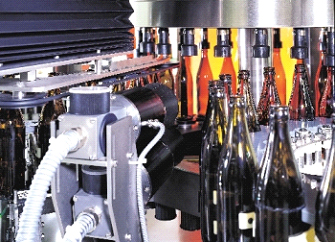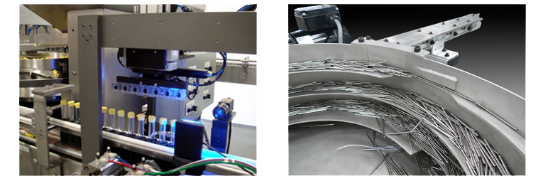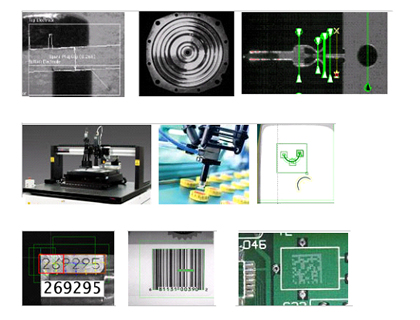Get the price immediately (currently in stock) click Here....
Machine Vision system by Grups Automation
While human inspectors operational on assembly lines visually inspect parts to evaluate the quality of workmanship, machine vision systems use cameras and image processing software to perform parallel inspections. Grups Automation developed Machine Vision inspection plays an significant role in achieving 100% quality control in manufacturing, falling costs and ensuring a high level of customer fulfillment.
Machine vision system inspection consists of hardly defined tasks such as counting objects on a conveyor, reading serial numbers, and searching for surface defects. Manufacturers often prefer machine vision systems for visual inspections that need high speed, high magnification, around-the-clock operation, and/or repeatability of measurements.
For example, semiconductor fabrication depends greatly on vision inspection technology, without which yields for computer chips would be significantly reduced. Machine vision systems inspect silicon wafers, processor chips, and sub-components such as resistors and capacitors at high speeds with precision and accuracy.

We have develop automatic online inspection system . many times is necessary to conduct visual inspection of any product like pet , brush , small box . Conventional methods of inspection is done by human being . This has it own limitation like Low speed of inspection , Errors , dependability on manpower . With the help of online inspection methods will solve all above problems
The human eyes are one of the most important organs of the human body and our skills really depend on our capacity to see, recognize and distinguish objects and to estimate distances. Most of the jobs depend on our ability of visual opinion. As amazing as the human sense of vision may be, we must acknowledge that today's production technology more and more often extend well beyond the limits of human visual capacities. This is where machine vision technology comes in.
What do we actually mean when we talk about machine vision or vision technology? It does not mean graphics or design: instead, it concerns the technology of artificial vision. Cameras and computers give machines or devices the ability to actually "see", to
Identify objects or situations and to make the right decisions accordingly

Machine vision refers to the industrial application of vision technology. It shows the Understanding and interpretation of technically obtained images for controlling production Processes. It has evolved into one of the key technologies in industrial automation, which is used in virtually all manufacturing industries
Following are different application of Vision system .
• Online vision inspection of dimensions of Product
• Online vision inspection of Defect in Product
• Online vision inspection amount of material filled in Product ( Transparent )
• Online vision inspection of Label Printing on the box
• Online vision inspection of position of the product like orientation in degree.
• Inspecting of the surfaces of bathtubs for scratches.
• Checking whether airbags have been properly installed into cars.
• Applying adhesives evenly and correctly.
• Verifying that welds are strong enough.
• Checking paper in the production process for flaws.
• Making sure that syringes are manufactured properly.
• Finding irregularities on flat glass.
• Guiding robots so that they can adapt to changes in their environment.
• Reading license plates of cars.
• Recognising and identifying persons.
• Reading addresses on parcels and checking their dimensions.
From a vision inspection system for checking out of tolerance components, counting systems for bagging machines, utilizing the latest pneumatic and electric linear slide systems Grups Automation can supply a system to move control and handle your components.
Grups Automation has a team of qualified engineers to take your components from bulk, orientate, convey, inspect and place into your special purpose machine. From initial enquiry Grups Automation can offer a concept and design solution utilizing its standard products as the core of a system with the aid of partners in the automation industry.
Bowl feeders and centrifugal systems have been used in many applications to feed components to a vision inspection system or specialized camera stations. From a simple intelligent sensor system to a full colour pixel camera recognition system Grups Automation can offer a bespoke package to suit your quality control requirements.
Grups Automation have experience of inspecting components down to 0.02mm ,and have supplied camera systems to inspect for surface defects, sort components into batches for colour and size and also for orientation purposes where a mechanical solution cannot be used.
Our in house engineers will supply a bespoke software package and PLC control to suit each system requirements. All standard platforms of PLC operating software and hardware can be catered for.
Our experienced team are of specialists are available to provide advice and to offer a solution which meets your specific needs.
What are the advantages of using machine vision systems?
First and foremost, the quality of the product is increased. Sample testing can often be replaced by 100 percent quality checks. In the example of paper production this means that every single square inch of paper produced has been reliably checked for flaws ‘on the fly'. The result is a superior product. The same applies to the printing of patterns on textiles or the production of sheet metals: The manufacturer guarantees a 100 % perfect delivery, which is especially important if products are safety-critical. Secondly, machine vision can lead to high cost reductions. Often, vision systems are employed in the early production stages. Defective parts are immediately removed from the manufacturing process. In many cases the removed part can be re-introduced into the production process. This saves materials. Defective parts never continue on to subsequent manufacturing stages and therefore incur no further costs. At the same time the system may become ‘selflearning' in that it recognise recurrent defects. Machine visiontechnology is unique in its ability to resolve the trade-off between raising quality and cutting costs. Examples abound in which machine vision does both jobs at a time.
Its benefits are as follows
• High speed inspection
• Low percentage of error
• 24 x 7 working
• No dependability of man power

QUALITY INSPECTION
Grups Automation Provides machine vision for quality inspection within our systems can fall into three categories:
• Defect Detection
• Tolerance Monitoring with Dimensions measurement
• Component Measurement
DEFECT DETECTION
Defect detection refers to the automatic inspection of customer parts looking for potential defects. Defects can be Minor or affect product Operation. Some defect detection examples include:
• Suture edge sharpness and cut angle
• Glass vial cracks
• Particulate matter
TOLERANCE INSPECTION
A good quality system uses as much response as it can to keep the process in control. Machine vision inspection systems can be difficult in monitoring process related tolerances and allowing the associated control systems to adjust for those trending towards boundary conditions. Typical vision tolerance monitoring systems Grups Automation have implemented include:
• Temperature monitoring by way of IR heat signatures
• Final part positioning
• Punch wear cycles based on cut edge quality and shape
COMPONENT MEASUREMENT
Many products produced by Grups automation have stringent specifications on the dimensions and shape of their essential components. Grups Automation vision systems are widely used to make sure that the components our automation is assembling are up to standard, or else they are rejected before even entering the process. Some typical measurements might be:
• Plastic molded short shot detection
• Component color check
• Tube fill levels
PROCESS AUTOMATION
While some inspection vision systems provide feedback data to the customer about their product quality and process capability, other vision systems are regularly implemented to assist the automation equipment itself to perform the duties it was designed to undertake. These systems can be expanded into these three areas:
• Alignment Feedback and Robot Guidance
• Part Presence and Orientation
• Barcode Traceability and Print Verification